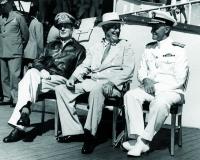
Gen. Douglas MacArthur (left), Pres. Franklin D.Roosevelt, and Adm. Chester Nimitz, aboard USS Baltimore, Pearl Harbor, US Territory of Hawaii, 26 July 1944.
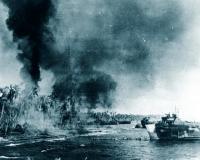
Oct. 20, 1944, U.S. troops head toward the beaches of Leyte Island during the amphibious assault to reconquer the Philippines.
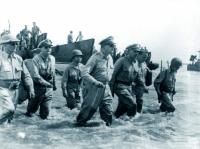
Oct. 20, 1944, Gen. Douglas MacArthur (c) is accompanied by Sergio Osmeña, Philippines' pres. in exile(l), as he wades ashore during landing operations at Leyte, after U.S. forces recaptured the beach.
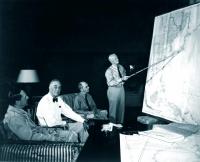
US President Franklin D Roosevelt in conference with General MacArthur (l), and Admirals William Leahy, and Chester Nimitz(r), US Territory of Hawaii, 26 Jul-10 Aug 1944.
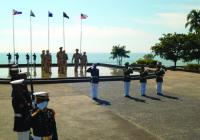
Monument marking the location of Gen. Douglas MacArthur's return to the Philippines, a Philippine Marine Corps honor guard stands at attention during the playing of Taps.
THIS WEEK, seventy years ago, General Douglas MacArthur, Supreme Commander of Allied Forces in the Southwest Pacific Area, made good on his promise to return to the Philippines, which he had abandoned, when, on March 12, 1942, he left embattled American and Filipino forces at Bataan and Corregidor and sailed to the safety of Australia. For abandoning his troops, General MacArthur was awarded, at the instigation of General George C. Marshall, the Medal of Honor. Since his father, Arthur, had received the same honor, they became the only father and son to have received the Medal of Honor, until 2001 when Theodore Roosevelt received it for his service during the Spanish-American War. General Theodore Roosevelt, Jr. received it for his service during the Normandy Invasion in June 1944. Both Roosevelts received their awards posthumously.
In July 1944, President Franklin Delano Roosevelt met with General MacArthur in Hawaii, “to determine the next phase of action against Japan.” Admirals Chester W. Nimitz and Earnest J. King, Commander-in-Chief, United States Pacific Fleet and Chief of Naval Operations, respectively, advocated bypassing the Philippines and heading straight for Formosa. However, MacArthur argued that the United States had a moral obligation to liberate the Philippines. Having promised, on his departure, that “I shall return,” his prestige was on the line. Militarily, the Admirals were probably correct, but the President was considering the postwar world, so he sided with MacArthur.
On October 20, 1944, 100,000 soldiers from the Sixth Army, commanded by Walter Kreuger, began landing on the Island of Leyte at 10:00 a.m. From the X Corps, commanded by General Franklin C. Sibert, came the First Calvary Division, commanded by Major-General Verne D. Mudge and the 24th Infantry Division, commanded by Major-General Frederick A. Irving. From the XXIV Corps, commanded by John R. Hodge, came the 96th Infantry Division, commanded by Major-General James L. Bradley and the 7th Infantry Division, commanded by Major-General Archibald V. Arnold.
The defense of the Philippines had been entrusted to Tomoyuki Yamashita, who, on October 10, 1944, took command of the 14th Area Army. General Yamashita had been commander of the 30,000 men comprising the 25th Army, which, in February 1942, captured Singapore and 130,000 British, Indian and Australian soldiers - the largest surrender of British led personnel in history - earning the General the sobriquet, “Tiger of Malaya.” To defend the island of Leyte, stood the 16th Division, under the command of Lt. General Shiro Makino.
At the time, the Island had a population of 900,000. Today its population has more than doubled. The island is 110 miles long and 40 miles wide, at its widest point. At its closest, it is only 1.2 miles from its neighbor, Samar Island, and separated from it by San Juanico Strait. Leyte is separated from Mindanao by the Surigao Strait.
At 1:30 in the afternoon, MacArthur, with cameras rolling, made his dramatic entrance onto the island, announcing, on radio, “People of the Philippines, I have returned! By the grace of almighty God, our forces stand again on Philippines soil.”
General Bradley’s 7th Infantry Division captured the town of Dulag on Leyte Gulf, which today has a population of 40,000. The following day the capital of Leyte, Tacloban, was captured by General Mudge’s First Cavalry Division. Today, Tacloban has a population of 220,000 - or it did before Typhoon Haiyan devastated it last year. On October 23, General MacArthur, accompanied by the Philippine President, Sergio Osmeña, restored the civil government and made Tacloban the temporary capital of the Philippines.
The coastal town of Carigara was taken by General Sibert’s X Corps. The town currently has a population of 45,000.
The Imperial Japanese Navy began transferring reinforcements and supplies to Leyte. By November 12, 45,000 additional soldiers and 10,000 tons of supplies had arrived on the island. These troops were organized into the 35th Army, under the command of General Sosaku Suzuki. But the naval operations had been costly for the Japanese Navy.
The Americans received reinforcements, on November 22, in the form of the 11th Airborne Division, led by Major-General Joseph M. Swing.
On December 7, the 77th Infantry Division, commanded by Major-General Andrew D. Bruce landed on the other side of the island, near Ormoc. Today, the city has a population of 190,000. Three days after the landing, elements of the 77th Division entered the city.
General Krueger peeled off Major-General Roscoe B. Woodruff’s 24th Infantry Division and sent it to invade the island of Mindoro, on December 15. With a size of 4000 square miles, Mindoro is the seventh largest island in the Phillipine archiepelgo. It is located off the southern coast of Luzon and today has a population of 1,200,000. The island was secured within two days.
The small port of Palompon, on Leyte, was captured by General Bruce’s 77th Division on Christmas Day. The next day, Gen. MacArthur announced the end of organized resistance, and transferred responsibility for Leyte and Samar Islands to Eighth Army, commanded by Robert L. Eichelberger, as General Krueger’s Sixth Army prepared to assault Luzon.
General Yamashita, speaking from his headquarters in Manila, on December 30, informed the Japanese defenders that they were on their own, that there would be no more attempts to reinforce or resupply them, nor would they be evacuated. General Suziki died in March, when the boat on which he was trying to leave the island was attacked by American planes and sunk. Mop-up operations continued on Leyte until May 8, 1945.
The unsuccessful defense of Leyte Island had been very costly for the Japanese. Losses included: 49,000 dead soldiers; 26 major warships; 46 large transports; hundreds of merchantmen; 50 percent of their land-based air power. A further 24,294 Japanese soldiers were killed in the “mopping up” operations. The Americans suffered 15, 584 casualties, of which 3,504 were fatalities. It was said that, “The Japanese fought to die, and the Americans fought to live!”
NEXT WEEK: BATTLE OF LEYTE GULF
Mr. Wimbrow writes from Ocean City, Maryland, where he practices law representing those persons accused of criminal and traffic offenses, and those persons who have suffered a personal injury through no fault of their own.




